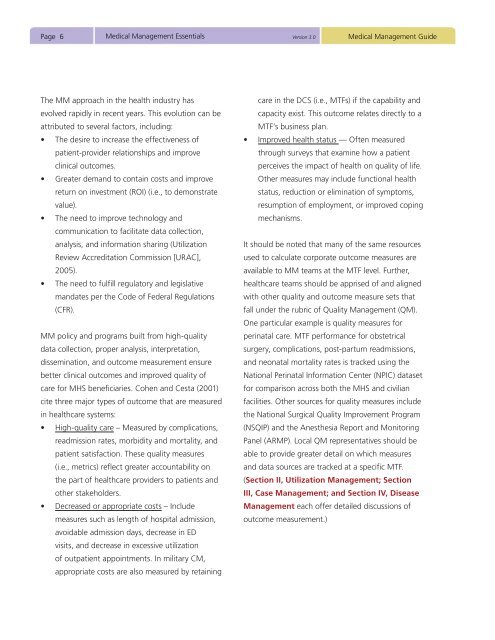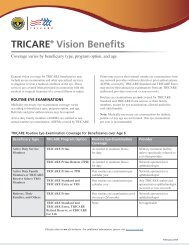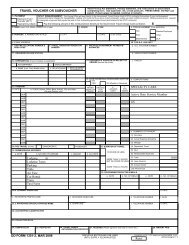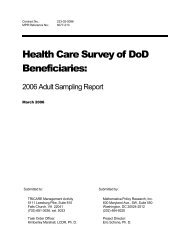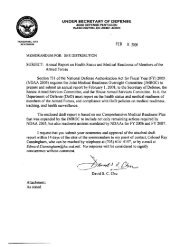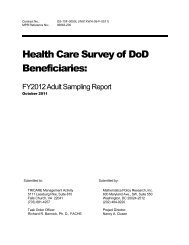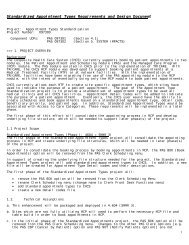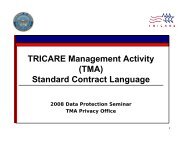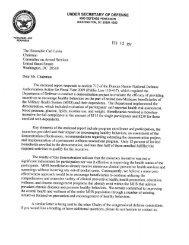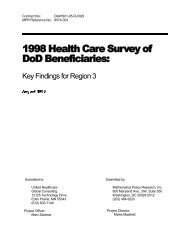Medical Management Guide, 2009, Version 3.0 - Tricare
Medical Management Guide, 2009, Version 3.0 - Tricare
Medical Management Guide, 2009, Version 3.0 - Tricare
- No tags were found...
Create successful ePaper yourself
Turn your PDF publications into a flip-book with our unique Google optimized e-Paper software.
Page <strong>Medical</strong> <strong>Management</strong> Essentials<strong>Version</strong> <strong>3.0</strong><strong>Medical</strong> <strong>Management</strong> <strong>Guide</strong>The MM approach in the health industry hasevolved rapidly in recent years. This evolution can beattributed to several factors, including:• The desire to increase the effectiveness ofpatient-provider relationships and improveclinical outcomes.• Greater demand to contain costs and improvereturn on investment (ROI) (i.e., to demonstratevalue).• The need to improve technology andcommunication to facilitate data collection,analysis, and information sharing (UtilizationReview Accreditation Commission [URAC],2005).• The need to fulfill regulatory and legislativemandates per the Code of Federal Regulations(CFR).MM policy and programs built from high-qualitydata collection, proper analysis, interpretation,dissemination, and outcome measurement ensurebetter clinical outcomes and improved quality ofcare for MHS beneficiaries. Cohen and Cesta (2001)cite three major types of outcome that are measuredin healthcare systems:• High-quality care – Measured by complications,readmission rates, morbidity and mortality, andpatient satisfaction. These quality measures(i.e., metrics) reflect greater accountability onthe part of healthcare providers to patients andother stakeholders.• Decreased or appropriate costs – Includemeasures such as length of hospital admission,avoidable admission days, decrease in EDvisits, and decrease in excessive utilizationof outpatient appointments. In military CM,appropriate costs are also measured by retainingcare in the DCS (i.e., MTFs) if the capability andcapacity exist. This outcome relates directly to aMTF’s business plan.• Improved health status — Often measuredthrough surveys that examine how a patientperceives the impact of health on quality of life.Other measures may include functional healthstatus, reduction or elimination of symptoms,resumption of employment, or improved copingmechanisms.It should be noted that many of the same resourcesused to calculate corporate outcome measures areavailable to MM teams at the MTF level. Further,healthcare teams should be apprised of and alignedwith other quality and outcome measure sets thatfall under the rubric of Quality <strong>Management</strong> (QM).One particular example is quality measures forperinatal care. MTF performance for obstetricalsurgery, complications, post-partum readmissions,and neonatal mortality rates is tracked using theNational Perinatal Information Center (NPIC) datasetfor comparison across both the MHS and civilianfacilities. Other sources for quality measures includethe National Surgical Quality Improvement Program(NSQIP) and the Anesthesia Report and MonitoringPanel (ARMP). Local QM representatives should beable to provide greater detail on which measuresand data sources are tracked at a specific MTF.(Section II, Utilization <strong>Management</strong>; SectionIII, Case <strong>Management</strong>; and Section IV, Disease<strong>Management</strong> each offer detailed discussions ofoutcome measurement.)


